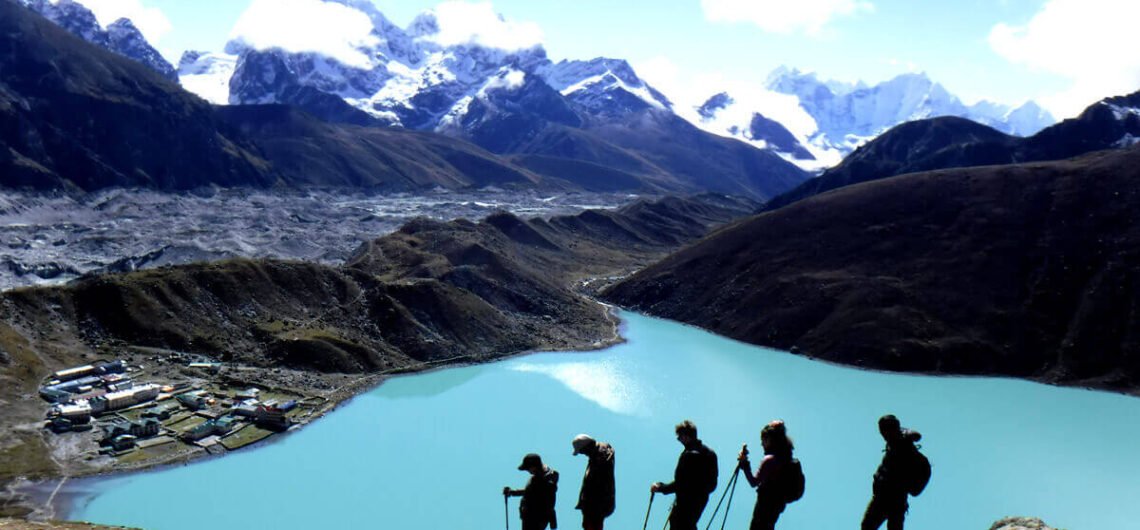Sagarmatha National Park Nestled in the heart of the Himalayas, is a testament to Nepal’s natural grandeur and cultural richness. This UNESCO World Heritage Site is home to Mount Everest, the world’s highest peak, and offers an unparalleled adventure for nature lovers, trekkers, and cultural enthusiasts. Join me as we embark on a journey through this breathtaking park, delving into its history, culture, and a detailed itinerary to make the most of your visit.
Sagarmatha National Park : A Glimpse into History
Sagarmatha National Park, established in 1976, spans over 1,148 square kilometers of rugged terrain and towering peaks. The name “Sagarmatha” is derived from the Nepali words “Sagar” meaning sky and “Matha” meaning head, symbolizing the towering peaks that seem to touch the sky. The park was designated a UNESCO World Heritage Site in 1979, recognizing its exceptional natural beauty and unique biodiversity.
The Cultural Tapestry
The park is not just about towering mountains; it’s also a cultural mosaic. The indigenous Sherpa community, renowned for their mountaineering skills, call this region home. The Sherpas follow Tibetan Buddhism, and their spiritual heritage is visible in the numerous monasteries, chortens (Buddhist shrines), and prayer wheels scattered throughout the park. One of the most significant cultural landmarks is the Tengboche Monastery, a spiritual center offering insights into the Sherpa way of life and breathtaking views of Mount Everest.
Detailed Itinerary
Day 1: Arrival in Kathmandu
Morning: Arrive at Tribhuvan International Airport, Kathmandu. Transfer to your hotel.
Afternoon: Explore the vibrant streets of Thamel, a bustling area filled with shops, restaurants, and trekking gear stores.
Evening: Visit Swayambhunath Stupa (Monkey Temple) for panoramic views of Kathmandu Valley.
Day 2: Kathmandu to Lukla and Trek to Phakding
Morning: Early flight to Lukla (2,800m), the gateway to Everest. The flight offers stunning aerial views of the Himalayas.
Afternoon: Begin your trek to Phakding (2,652m). It’s a gentle walk through picturesque villages and dense forests.
Evening: Rest and acclimatize in Phakding.
Day 3: Phakding to Namche Bazaar
Morning: Trek through pine forests and cross the Dudh Koshi River via suspension bridges, entering Sagarmatha National Park.
Afternoon: Climb steeply to Namche Bazaar (3,440m), the main trading hub of the Khumbu region.
Evening: Explore local markets and acclimatize.
Day 4: Acclimatization Day in Namche Bazaar
Morning: Hike to the Everest View Hotel for stunning views of Everest, Lhotse, and Ama Dablam.
Afternoon: Visit the Sherpa Culture Museum and the Sagarmatha National Park Visitor Centre.
Evening: Relax and enjoy the lively atmosphere of Namche Bazaar.
Day 5: Namche Bazaar to Tengboche
Morning: Trek through rhododendron forests and enjoy panoramic mountain views.
Afternoon: Arrive in Tengboche (3,860m) and visit the famous Tengboche Monastery.
Evening: Witness a serene evening prayer session at the monastery.
Day 6: Tengboche to Dingboche
Morning: Descend to the Imja Khola and then climb towards Pangboche village.
Afternoon: Continue to Dingboche (4,410m), surrounded by impressive peaks.
Evening: Rest and acclimatize.
Day 7: Acclimatization Day in Dingboche
Morning: Hike to Nagarjun Hill for acclimatization and panoramic views.
Afternoon: Explore the village and learn about high-altitude farming.
Evening: Relax and prepare for the higher altitudes ahead.
Day 8: Dingboche to Lobuche
Morning: Trek towards Thukla, passing the memorials of climbers who perished on Everest.
Afternoon: Continue to Lobuche (4,940m), with views of Nuptse and other peaks.
Evening: Rest and acclimatize.
Day 9: Trek from Lobuche to Gorak Shep and Everest Base Camp
Morning: Trek to Gorak Shep (5,170m), the last stop before Everest Base Camp.
Afternoon: Continue to Everest Base Camp (5,364m), marvel at the Khumbu Icefall.
Evening: Return to Gorak Shep for the night.
Day 10: Gorak Shep to Kala Patthar and Pheriche
Morning: Early morning hike to Kala Patthar (5,545m) for a sunrise view of Everest.
Afternoon: Descend to Pheriche (4,371m) for a more comfortable altitude.
Evening: Rest and reflect on your achievements.
Day 11: Pheriche to Namche Bazaar
Morning: Retrace your steps back to Namche Bazaar.
Afternoon: Enjoy the easier descent and the familiar scenery.
Evening: Celebrate your trek with fellow trekkers.
Day 12: Namche Bazaar to Lukla
Morning: Trek back to Lukla, enjoying the final leg of your journey.
Afternoon: Arrive in Lukla and relax.
Evening: Reflect on your adventure and prepare for your flight back.
Day 13: Lukla to Kathmandu
Morning: Fly back to Kathmandu.
Afternoon: Transfer to your hotel and relax.
Evening: Explore more of Kathmandu or rest after your trek.
Day 14: Departure
Morning: Free time for shopping.
Afternoon: Transfer to Tribhuvan International Airport for your departure.
Final Thoughts
Sagarmatha National Park is more than just a destination; it’s an experience that combines the thrill of adventure with the serenity of nature and the richness of culture. Whether you’re a seasoned trekker or a curious traveler, the park offers something for everyone. From the awe-inspiring views of Mount Everest to the warm hospitality of the Sherpa people, your journey through Sagarmatha National Park will be an unforgettable adventure. So pack your bags, lace up your boots, and get ready to touch the sky in this Himalayan wonderland.
Credit Source —> https://national-parks.org/nepal/sagarmatha
